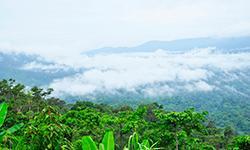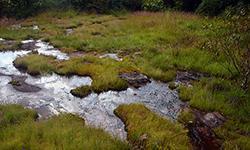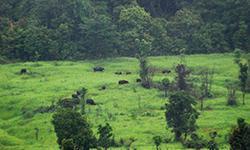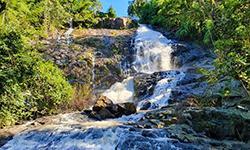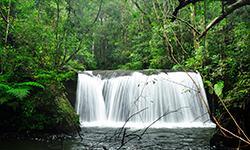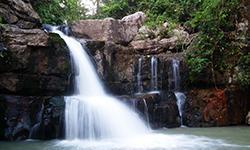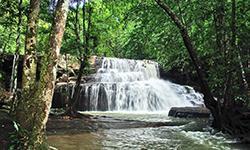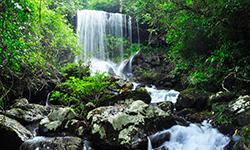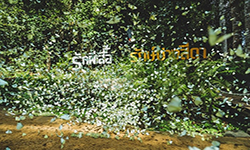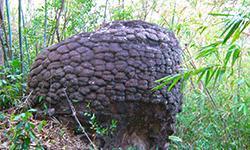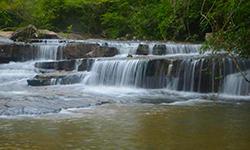Pang Sida National Park
Contact Location : Pang Sida National Park, P.O. Box 55, Tha Yaek Sub-district, Mueang Sa Kaeo District, Sa Kaeo Province, 27000
Telephone Number : (+66) 3 724 7948, (+66) 8 1862 1511 Fax: (+66) 3 724 7632
Email : pangsida@live.com
Facebook : Pang sida National Park
Information
Pang Sida National Park covers Ta Phraya, Watthana Nakhonand Mueang District, Sa Kaeo Province, and Na Di District, Prachin Buri Province. The fertile forest contains valuable natural resources such as Pang Sida Waterfall, Pha Ta Khian Waterfall, Khwae Makha Waterfall, viewpoints, and strange rock formations along the river. It has an area of approximately 527,500 rai, or 844 square kilometers.
Background
Initially, Pang Sida Waterfall was one of the units in the mountainous plain development project of Prachin Buri Province. It was a royal project of His Majesty the King Rama IX, intending to develop the area surrounding Pang Sida Waterfall as a tourist attraction and to protect watershed areas and natural forest conditions.
The Royal Forest Department therefore established Pang Sida Forest Park in 1978. Later, the Royal Forest Department's National Park Division prepared a preliminary survey report for Pang Sida Waterfall Forest and adjacent areas to be designated as a national park. There was a royal decree specifying the land area of Kaeng Dinso Forest, Kaeng Yai Forest, Khao Saton Forest, and Tha Krabak Forest; Kaeng Dinso Sub-district, Na Di District, Ban Kaeng, Tha Yaek and Khok Pi Khong Sub-district, Sa Kaeo District, Nong Nam Sai, Chong Kum and Sae-O Sub-district, Watthana Nakhon District, Prachin Buri Province to be a national park. The Pang Sida National Park establishment was announced in the Government Gazette, Volume 99, Section 24, dated February 22, 1982, and it is the 41st national park in Thailand.
Currently, Pang Sida National Park is located in Mueang, Watthana Nakhon and Ta Phraya District, Sa Kaeo Province, and Na Di District, Prachin Buri Province. It is located in the southern part of the Phanom Dongrak Mountain range and covers an area of approximately 527,500 rai, or 844 square kilometers. There are abundant forests that contain significant and valuable natural resources, such as wildlife and beautiful scenery. Most of the terrain is complex, high mountains. There are many types of plants, including the tropical rainforest, dry evergreen forest, hill evergreen forest, mixed deciduous forest, deciduous dipterocarp forest, and grassland forest, which are suitable for being preserved for research in forestry, wildlife and tourism.
The tourist highlights are Pang Sida Waterfall, Pha Ta Khian Waterfall, Khwae Makha Waterfall Group, Khang Khao Waterfall Group, Phu Khao Chedi Mountain, Dinosaur Fossil, Phra Prong Reservoir and Butterfly Watching. It is recognized as the best butterfly-watching spot in the East Region.
Note : After paying the entrance fee to the National Park, please carry the receipt for inspection.
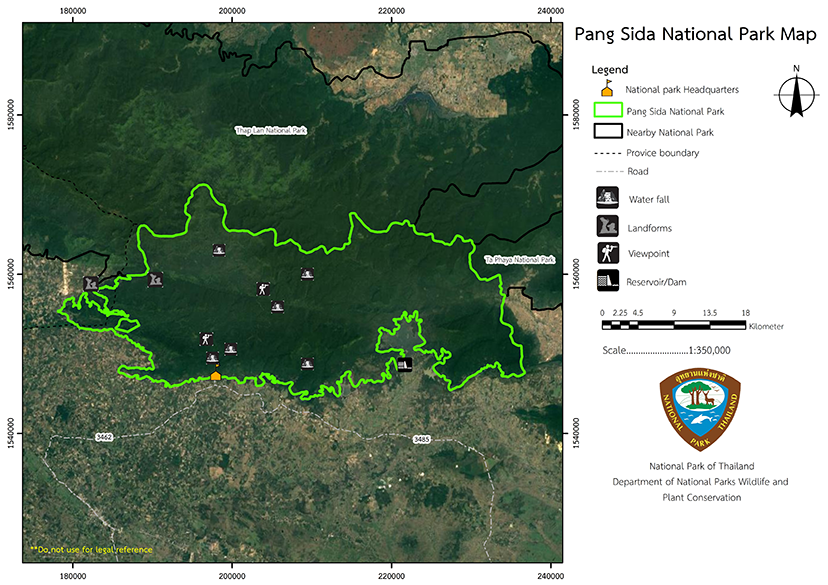
527,500 rai (844 square kilometers)
|
The viewpoint at milestone No. 25th |
Lan Hin extraction point |
||
|
Bu Ta Pot meadow |
Khwae Makha Waterfall |
||
|
Tham Khang Khao Waterfall |
Thap Sung Waterfall |
||
|
Thap The Wa Waterfall |
Pang Sida Waterfall |
||
|
Pha Ta Khian Waterfall |
Pong phisuea |
||
|
Phu Khao Chedi |
Lan Hin Dat Waterfall |
||
Nature trails ⇔ Trekking ⇔ Visit Waterfall ⇔ Observe flowers/plants ⇔ Bird/Butterfly ⇔ Stargazing ⇔ Mountain biking ⇔ Camping
Welfare shop : not available
Mobile phone signal :
1. National Park Headquarters: AIS, TRUE, DTAC
2. Tourist service zone area: AIS, TRUE, DTAC
3. Accommodation areas: AIS, TRUE, DTAC
|
|
Pang Sida National Park is located in the southern part of the Phanom Dongrak Mountain range. The majority of the terrain is composed of steep and complicated mountains. There is a fertile forest that is the headwaters of many creeks that converge to form the Bang Pakong River. The area's natural landscape slopes from north to south. When it rains heavily, rainfall from the mountains flows rapidly to the bottom, because the gradient is quite high.
|
|
The climate of Pang Sida National Park is a tropical grassland (Savanna Climate). It is moist and rainy during the southwest monsoon season, but in the northwest monsoon season or winter, the weather is dry. Summer starts from mid-February to mid-May, when the weather is generally sweltering, especially in April. Between mid-May and mid-October, when the southwest monsoon blows into Thailand, rainy season begins. The weather will be moist and rainy from May onwards. Winter lasts from mid-October to mid-February, which is the northeast monsoon period, and the weather is generally dry, but it is not very cold due to the wind from the sea.
|
|
|
|
Flora and Wildlife The results can be summarized as follows: The tropical rain forest (a moist evergreen forest) is scattered throughout the area. It is located at an altitude of 400 -1000 meters above mean sea level, covering most of the park, about 302,123.88 rai or 57.24 % of the forest area. The plants found are similar to those of dry evergreen forests. However, there are more plants in the Dipterocapaceae family, including Dipterocarpus dyeri Pierre , Dipterocarpus baudii Korth, Dipterocarpus gracilis Blume , and Anisoptera costata Korth. Along the ravine, plants that can be commonly found are Duabanga grandiflora wood or Duabanga grandiflora Walp , and Wild Cinchona (Anthocephalus chinensis). Dendrocalamus longispathus is usually found around the streams. In the relatively high area, there are no Dipterocarpus dyeri Pierre), Dipterocarpus baudii Korth, and Black Rosewoodbut there are Polyalthia obtusa Craib and Rubber trees instead., Additionally, there are Shorea henryana, Sasamala, Chorospondias aXIllaris, White champaka, Calophyllum thorelii Pierre, and Needle wood. The understory layer wood is from the Fagaceae family, such as Lithocapus annamensis, Quercus semiserrata , Quercus myrsinifolia Blume , Evergreen Chinkapin (Castanopsis acuminatissima (Blume) A.DC.) , and Clerodendrum infortunatum L. (Ligustrum Confusum). There are several types of shrubs, including Ampelocissus martini (Embelia Ribes), Maesa ramentacea (Roxb.) A. DC. , Viburnum punctuatum, Sambucus javanica , Uncaria homomalla, and Entada rheedii, Aralia armata. On the banks of the stream there are plants in the family Athyriaceae such as Cyathea podophylla and Alsophila latebrosa growing mixed with Pseudodrynaria coronans. Common orchids commonly found are Aerides falcata Lindl. and Vanda pumila Hook.f. Dry evergreen forest is scattered throughout the eastern part of the park at high altitudes ranging from 100 - 400 meters above sea level. It is the second-largest area of the National Park, at 154,452.80 rai, or 29.26 percent. The common plants are Dipterocarpus alatus, Dipterocarpus turbinatus C.F. Gaertn. , Shorea henryana, White-meranti (Shorea roxburgii), Hopea odorata, Hopea ferrea, White Myrtle, Black Rosewood, Tetrameles, Erythrophleum succirubrum Gagnep., Memecylon caeruleum Jack .. There are also two types of tall palm trees: Areca triandra and Lan (Fan Palm). The understory layer woods are species in the families of Marantadeae, Phrynium and Curcuma,, Zingiberceaefamily, Achasma, Curcuma, Amomum, cambium, and Ctenolopon growing mixed up with wild orchid (Musa acuminata) and Pandanus. The Mixed Deciduous Forest area is located in the southern part of the park, covering the third largest area of the park, 32,146.89 rai (51.4350 square kilometers), or approximately 6.09 percent of the forest. Plants in typical consists of Black rosewood (Afzelia xylocarpa), Pterocarpus macrocarpus Kurz, Lagerstroemia calyculata,Pterocymbium tinctorium (Blanco) Merr. (Pterocymbium javanicum), Gamari (Gmelia arborea),Adina pinata, and Anogeissus acuminata (Roxb. ex DC.) Guill. The undergrowth plants are Bambusa arundinacea, and various types of grasses. The bamboo forest is scattered in the middle of the park. It covers an area of 4,419.55 rai, or about 0.84 percent of the forest area. Most species are wild bamboo (Bambusa arundinacea). The Secondary Forest and Abandoned Farm Grasses, shrubs and groves are plants that have re-grown after old plant community in the invasion area that had been cleared and left. This type of forest runs parallel to the park's southern border, covering an area of approximately 7,177.11 rai (11.4834 square kilometers) and 5,745.93 rai (0.0016 square kilometers) respectively. The cause of the grassland and the secondary forest is the same as in Khao Yai National Park due to the shifting cultivation system before the national park establishment. After people were evacuated down to the plains, the farm area was abandoned. Much of the are became the Imperata cylindrica grasslands which were frequently burnt. In some areas where the fire is contained, the grassland develops into a grove or secondary forest. In this kind of forest, many types of pioneer species are often found and can be classified into two groups; the top canopy and shrub layer. There are abundant wildlife habitats in Pang Sida National Park, Sa Kaeo, and Prachin Buri Province. According to the studies of vertebrate wildlife about their quantities and biology, they can be divided into five groups: mammals, birds, reptiles, amphibians, and freshwater fish, with a total of 278 species (Royal Forest Department, 2000). Details are as follows. A total of 267 species of wildlife were found in the winter survey, comprising 41 mammals, 188 species of birds, 26 species of reptiles and 12 species of amphibians, of which 267 species are classified as protected species. (224 species). Wild animals found according to the status of ONEP and IUCN are classified as critically endangered, namely freshwater crocodile (Crocodylus siamensis). - Endangered 4 species, including: Wild Elephants (Elephas maximus), Gray Heron (Ardea cinerea), Purple Herons (Ardea purpurea), and Elongated Tortoises (Indotestudo elongata). This wildlife found in the Pang Sida National Park also exists in different parts of Thailand, except for the Siamese crocodile (Crocodylus siamensis), which is nearly extinct. There are also many species of wildlife that are classified as endangered or vulnerable. Therefore, the Pang Sida National Park area can be developed as a center for natural study and research on wildlife, particularly in the Kaeng Yai Mak Siamese Crocodile (Crocodylus siamensis) conservation area which could be the only center in Thailand. Factors that may affect the livelihood of natural nature include the villagers' livestock near the nationalpark. This livestock may infiltrate the area and take over. The other significant issues are poaching or hunting wild animals, as well as water pollution caused by tourist activities during the high season, which may impede amphibian spawning. |
How to get there by car :
1. From Bangkok to Mueang District, Sa Kaeo Province, with a distance of 256 kilometers, take a bus along Highway No. 3462, Sa Kaeo Ban Khlong Nam Khiao. The Pang Sida National Park Headquarters is approximately 27 kilometers away from Sa Kaeo downtown.
How to get there by train
2. Take the Eastern Railway (Bangkok - AranPrathet), the first train departs at 6:00 hrs. and the second trip departs at 13:00 hrs. Get off at Sa Kaeo Railway Station and then take a bus from Sa Kaeo District to the National Park Headquarters as mentioned above.
- National Park Ranger Station Po Do. No. 1 (Huai Somong)
- National Park Ranger Station Po Do. No. 2 (Khlong Mak Nat)
- National Park Ranger Station Po Do. No. 3 (Khok Samphan)
- National Park Ranger Station Po Do. No. 4 (Dan Truat)
- National Park Ranger Station Po Do. No. 5 (Huai Nam Yen)
- National Park Ranger Station Po Do. No. 6 (Chong Klam Bon)
- National Park Ranger Station Po Do. No. 7 (Khlong Kluea)
- National Park Ranger Station Po Do. No. 8 (Phra Prong)
- National Park Ranger Station Po Do. No. 9 (Khao Huai Chan)
- National Park Ranger Station Po Do. No. 10 (Wang Khrok)
- National Park Ranger Station Po Do. No. 11 (Khao Thalai)
- National Park Ranger Station Po Do. No. 12 (Bu Ta Pot)
- National Park Ranger Station Po Do. No. 13 (Huai Dong)
- Visitor Center, Restaurants
- Welfare Shop
- Camping area
- Accommodation: Pang Sida 101 (Thap Sida)
- Accommodation: Pang Sida 102 (Soi Sida)
- Accommodation: Pang Sida 201 (Lan Sida)
- Guesthouse

